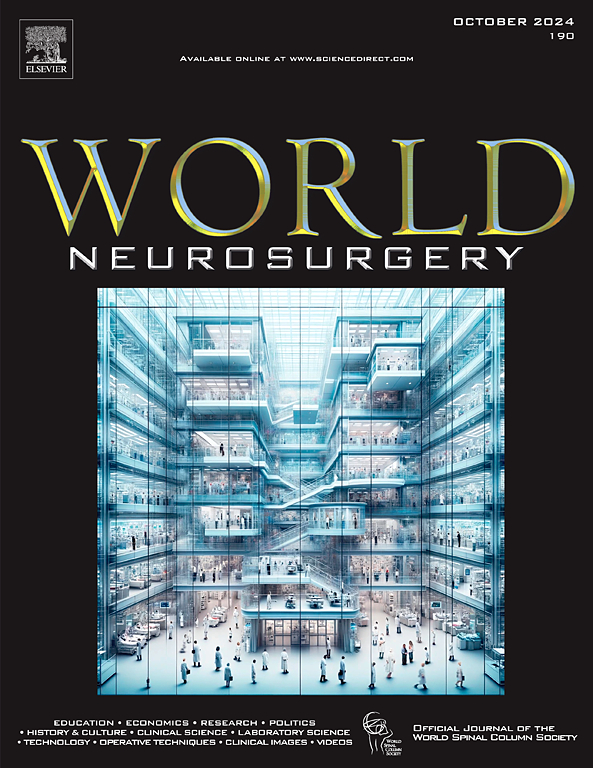Hypomagnesemia is Associated with the Skull Computed Tomography Black Hole Sign in Patients with Spontaneous Intracerebral Hemorrhage
IF 1.9
4区 医学
Q3 CLINICAL NEUROLOGY
引用次数: 0
Abstract
Objectives
The evaluation of hypomagnesemia's significance in predicting the presence of the black hole sign in patients with intracranial hemorrhage is currently under investigation.
Methods
The study included 261 patients with cerebral hemorrhage who underwent initial skull computed tomography within 24 hours of admission. Sixty-nine patients (26.4%) exhibited hypomagnesemia in the initial laboratory examinations. The black hole sign was observed in 123 patients (referred to as the black hole sign group, which includes patients with and without hypomagnesemia), while the remaining 138 patients (nonblack hole sign group) did not exhibit this feature. The values of hypomagnesemia were assessed through multivariable logistic regression analyses.
Results
The black hole sign occurred in 45 of the 69 (65.2%) patients with hypomagnesemia, and in 78 of the 192 (40.6%) patients without hypomagnesemia. In the black hole sign group, hypomagnesemia was observed in 45 patients (36.6%). However, only 24 patients (19.5%) from the normal magnesium concentration group exhibited hypomagnesemia. The sensitivity, specificity, and positive and negative predictive values of hypomagnesemia for predicting the black hole sign were 69.9%, 82.5%, 36.6%, and 82.8%, respectively. The odds ratios for hypomagnesemia, smoking history, and hypokalemia in predicting the presence of the black hole sign were 2.74, 1.971, and 1.629, correspondingly.
Conclusions
The presence of hypomagnesemia may serve as a predictive factor for the black hole sign and rebleeding in patients with intracerebral hemorrhage, thereby providing valuable guidance for clinical treatment.
自发性脑内出血患者的低镁血症与头颅 CT 黑洞征有关。
目的评估低镁血症在预测颅内出血(ICH)患者出现黑洞征象中的意义,目前正在研究中。方法研究纳入了入院后24小时内接受头颅计算机断层扫描(CT)的261例脑出血患者,其中69例患者(26.4%)在最初的实验室检查中表现出低镁血症。123 名患者(称为黑洞征象组,包括有和无低镁血症的患者)出现了黑洞征象,而其余 138 名患者(非黑洞征象组)则没有出现这一特征。结果69名低镁血症患者中有45名(65.2%)出现黑洞征象,192名无低镁血症患者中有78名(40.6%)出现黑洞征象。低镁血症预测黑洞征的敏感性、特异性、阳性预测值和阴性预测值分别为 69.9%、82.5%、36.6% 和 82.8%。结论低镁血症可作为脑内出血(ICH)患者出现黑洞征和再出血的预测因素,从而为临床治疗提供有价值的指导。
本文章由计算机程序翻译,如有差异,请以英文原文为准。
求助全文
约1分钟内获得全文
求助全文
来源期刊

World neurosurgery
CLINICAL NEUROLOGY-SURGERY
CiteScore
3.90
自引率
15.00%
发文量
1765
审稿时长
47 days
期刊介绍:
World Neurosurgery has an open access mirror journal World Neurosurgery: X, sharing the same aims and scope, editorial team, submission system and rigorous peer review.
The journal''s mission is to:
-To provide a first-class international forum and a 2-way conduit for dialogue that is relevant to neurosurgeons and providers who care for neurosurgery patients. The categories of the exchanged information include clinical and basic science, as well as global information that provide social, political, educational, economic, cultural or societal insights and knowledge that are of significance and relevance to worldwide neurosurgery patient care.
-To act as a primary intellectual catalyst for the stimulation of creativity, the creation of new knowledge, and the enhancement of quality neurosurgical care worldwide.
-To provide a forum for communication that enriches the lives of all neurosurgeons and their colleagues; and, in so doing, enriches the lives of their patients.
Topics to be addressed in World Neurosurgery include: EDUCATION, ECONOMICS, RESEARCH, POLITICS, HISTORY, CULTURE, CLINICAL SCIENCE, LABORATORY SCIENCE, TECHNOLOGY, OPERATIVE TECHNIQUES, CLINICAL IMAGES, VIDEOS
 求助内容:
求助内容: 应助结果提醒方式:
应助结果提醒方式:


